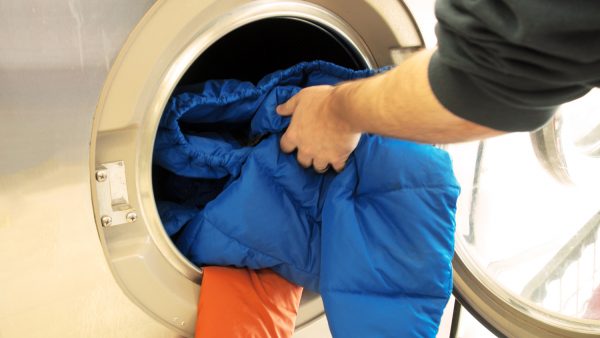Season’s Over; Isn’t It About Time You Get That Puffy Back To Clean?

Not only are your season-dirty down jackets, vests, and even sleeping bag dirty and smelly, if you left them that way, they would lose their heat-insulating properties. It is easy to destroy your down gear if you don’t follow some basic rules when washing them at home. It’s not difficult, but it does take some time and know-how.
You will need:
- a front load washing machine and a dryer (Top load machines are not recommended.)
- a bucket
- special down liquid detergent
- three-four new tennis balls or reusable drying balls
- a new sponge (for washing dishes)
- a clean toothbrush (or something similar)
- three hours of free time.
10 How To Steps
- Purchase a liquid detergent specially designed for down. Try either Granger’s or Nikwax. You will need about a cap (50 ml) for a jacket.
- Inspect the jacket and find especially dirty spots. A bright light really helps. Close all pockets, velcro, and zippers. Turn your jacket inside out.
- Soak your jacket in cold water in a clean bucket. Drip a bit of detergent on a sponge and create some foam. Apply foam on wet, dirty areas. Let foam to penetrate the fabric for five to 10 minutes. Brush the really dirty areas with toothbrush. Let it soak for 20 more minutes.
- Pull out the detergent dispensing tray of your washing machine, clean it thoroughly. Even a small amount of a wrong detergent or a softener can negatively affect the condition of the down.
-

Tennis Balls or Dryer Balls are needed to keep the fluff up. Credit: REI Take the bucket right next to the washer and gently dump your jacket inside the washer. Add three-four new tennis balls or reusable drying balls. Hint: no balls, no worries. Roll balls out of your heavy cotton socks, wet them, and throw into the washer.
- Fill one cap of the detergent, (or the recommended amount in the instructions), into the receiver for the liquid medium. All washers are different, so ideally you need the lowest temperature, the slowest speed, and the longest time —one hour or more. Press the button and…take a break: have a cup of coffee or mow the lawn.
- After the machine stops, look at the contaminated zones. Again, a bright light is your friend. If you still see dirt, repeat step three to five. Check again.
- Now, On to your dryer. Set the lowest temperature, the lowest speed, and the longest time . One and a half hours or more would be fine. Click the button and…take another break.
Pull out your clean, dry jacket and hang it on a wide hanger. Regardless of the price and the country of origin (China, Canada, Hungary) of a jacket, feathers may come out. It is just a question of when. This is a natural process, don’t be surprised if it happens to you. Do not pull out the protruding feather because you will create a larger hole in the fabric and way more feathers will follow. Try to push the feather back inside.
9. Almost all down jackets are only water-repellent and not water-resistant (unless they have membrane fabric like Gore-tex). A few percent of all down jackets do not even have water repellent properties. Those are designed to be a mid layer, which goes under a water resistant shell jacket. All the rest have a water-repellent coating. A smart user should restore this coating after washing, otherwise the fabric will absorb and even let moisture go through in case of rain or wet snow. And water is bad for down. Use a product for water-repellent restoration, typically in a spray. Again Granger’s and Nikwax are very reliable. Apply it according to the instructions. Let it dry.
10. Done! It is time to use your downy friend.













Sigh, I just take the jacket (it’s not down) to a sports gear repair shop in Seattle and just let them deal with it. They know what they’re doing and they restore the water resistance. After ruining a jacked some years ago, I figured it was cheaper in the long run to let a pro deal with it. I get it cleaned every second or third year. The jacket has now lasted (in virtually new shape) for some 10 plus years. Maybe now it’s more like 15. It’s Rainy Pass Repair. I clean the skis (the citrus cleaner is a good idea), then let the local shop put on a summer wax.